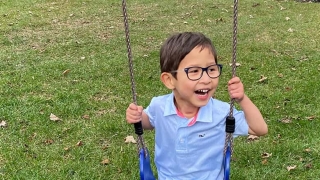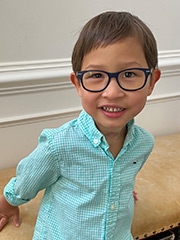Oliver’s Story: Prenatal and Postnatal Care of CDH and Giant Omphalocele
Published on
Published on
After struggling for years to get pregnant, Jeff and Janice were excited to learn they were expecting. At a 12-week ultrasound, they experienced the thrill of hearing the baby’s heartbeat for the first time, and then they learned unexpected news.
Their maternal-fetal medicine (MFM) specialist said the baby had an omphalocele, an abdominal wall defect in which the intestines, liver and other organs protrude through the belly button. The couple went to a specialized center in north Jersey for a second opinion, but the diagnosis and their worst fears were confirmed. It was then that they turned to CHOP.
“It was pretty overwhelming,” recalls Jeff. Scared and wanting to be in the very best hands possible, Jeff reached out to the Center for Fetal Diagnosis and Treatment (CFDT) at Children’s Hospital of Philadelphia, which is just an hour south from the family’s home. Center Director N. Scott Adzick, MD, and his team are pioneers in the field of fetal medicine.
 The CFDT’s multidisciplinary team includes experts in maternal-fetal medicine, reproductive genetics, obstetrics, surgery, anesthesiology, neonatology, fetal cardiology, genetic counseling, midwifery, fetal imaging, social work, psychology, psychiatry, child life, palliative care, lactation consulting, respiratory therapy and research. In addition, highly experienced advanced practice obstetric, neonatal and operating room nurses and dedicated fetal therapy coordinators navigate patients through their entire experience.
The CFDT’s multidisciplinary team includes experts in maternal-fetal medicine, reproductive genetics, obstetrics, surgery, anesthesiology, neonatology, fetal cardiology, genetic counseling, midwifery, fetal imaging, social work, psychology, psychiatry, child life, palliative care, lactation consulting, respiratory therapy and research. In addition, highly experienced advanced practice obstetric, neonatal and operating room nurses and dedicated fetal therapy coordinators navigate patients through their entire experience.
After a detailed evaluation, Jeff and Janice met with the center team and discussed the plan of care. “We were fully committed to giving our all for our child to have a fighting chance,” says Jeff. The couple would return to CHOP for regular checkups for the remainder of the pregnancy and Janice would deliver in CHOP’s Garbose Family Special Delivery Unit (SDU), close to CHOP’s Level IV Newborn/Infant Intensive Care Unit (N/IICU).
In follow-up examinations, a second potentially serious birth defect was discovered: eventration or congenital diaphragmatic hernia (CDH) with sac, a condition in which a hole in the diaphragm allows the contents of the abdomen to move into the chest and prevent lung development.
“The team at CHOP was very straightforward of the potential risks and road ahead, but very confident, and that put us at ease,” says Jeff. “That’s what we needed. We felt comfortable that we were in the best place we could be, so that gave us hope.”
The CFDT understands the emotional toll a high-risk pregnancy takes on expectant parents. The prospect of a newborn having a prolonged stay in the N/IICU further elevates the risk for psychological distress in parents after birth. The center’s multidisciplinary psychosocial support team works closely with the medical and nursing teams and offers a wide array of counseling and supportive services to help parents and families cope and feel emotionally supported through the time of fetal diagnosis and beyond neonatal discharge.
One such service is Mama Care, a support group that combines prenatal care, childbirth education and social support into one program. Mama Care provides families with unhurried time with their caregivers as well as an opportunity to form a community with other families who are going through a similar experience.
“These are complicated conditions that your family members and friends can’t relate to,” says Jeff. “Mama Care was a game changer because it let us know we weren’t alone. Given the stress that people are going through in these situations, to be able to have that outlet and make those relationships was extremely beneficial for us. It was just another source of hope to know that there were other people going through this and that the center had thought through more than just the delivery day.”
At a 36-week checkup, the care team discovered that the baby had a buildup of fluid around its lungs, known as a pleural effusion, and needed to be delivered immediately. Oliver (Olly for short) was born in the SDU on April 2, 2016, where he was swiftly stabilized by a ready-and-waiting team before being transported to the N/IICU.
During his time in the N/IICU, Olly underwent a number of surgeries under the care of CHOP’s unique Neonatal Surgical Team, including plication of the diaphragm, emergent abdominal exploration for segmental volvulus associated with Meckel’s diverticulum, and reversal of ileostomy. A tracheostomy tube placed halfway through his N/IICU stay made it easier for Olly to breathe and grow.
Jeff and Janice divided their time between home and Philadelphia to be with Olly while he was in the N/IICU, and after 10 months in the hospital, Olly was finally able to go home. It was “one of the most emotional days of our lives,” says Jeff. “Finally, we were able to be together as a family, at home.”
Janice, a lawyer, juggled working from home and caring for Olly with the assistance of a home care nurse during the day. It was a lot to manage at first: Olly had the trach and was on a ventilator that required more than 40 pounds of equipment. But before discharge, the team at CHOP had trained Jeff and Janice on how to care for Olly at home.
“CHOP gave us the confidence from day one to take care of him ourselves,” says Jeff.
A year after Olly was discharged from the hospital, the family suffered a tragic loss when Janice unexpectedly passed away. Her death was a shock to all who knew her, a former college athlete who had been in perfect health.
“Janice was incredibly dedicated to Olly’s care,” says Jeff. “She loved being a mom and was so grateful for our CHOP team.”
With the ongoing support of the CHOP care team along with a community of friends, family and home care nursing, Jeff navigated a new way forward to make sure Olly continued to get the care he required.
 If you met Oliver today, at age 4 and a half, you’d never imagine the challenges he’s been through since birth. His energy and curiosity have led him to make great strides. Not only has he attended preschool, Olly enjoys and excels in the common hobbies of most healthy 4-year-olds: dribbling a basketball while learning to count to 100, kicking his favorite soccer ball into the street, and cruising around the neighborhood on his bicycle.
If you met Oliver today, at age 4 and a half, you’d never imagine the challenges he’s been through since birth. His energy and curiosity have led him to make great strides. Not only has he attended preschool, Olly enjoys and excels in the common hobbies of most healthy 4-year-olds: dribbling a basketball while learning to count to 100, kicking his favorite soccer ball into the street, and cruising around the neighborhood on his bicycle.
Olly continues to be followed in CHOP’s Pulmonary Hypoplasia Program (PHP), which has celebrated his victories and continues to offer support throughout his care. When he was 3, his surgical team completed the closure of the omphalocele and repaired his recurrent CDH. Three months after those procedures, he had his tracheostomy removed.
In the spring of 2020, Oliver hit another big milestone: The feeding tube he had relied on during the night to supplement his diet was removed. And most recently, his tracheostomy stoma was surgically closed. Moving forward, Olly will continue to be followed by the team that has cared for him from the beginning. Knowing that puts Jeff at ease.
“From the first day we walked into Children’s Hospital, we knew we were in the right place, and that hasn’t changed,” says Jeff, now an active supporter of the Mama Care Program. “We look at the CHOP team as family and a place of miracles.”